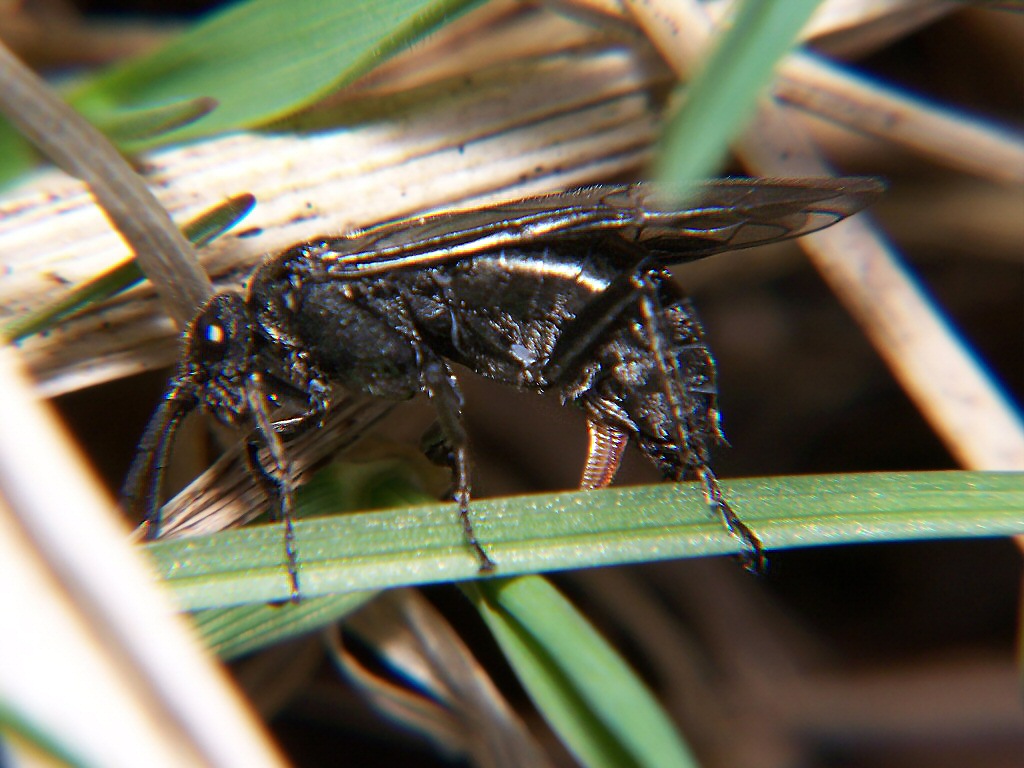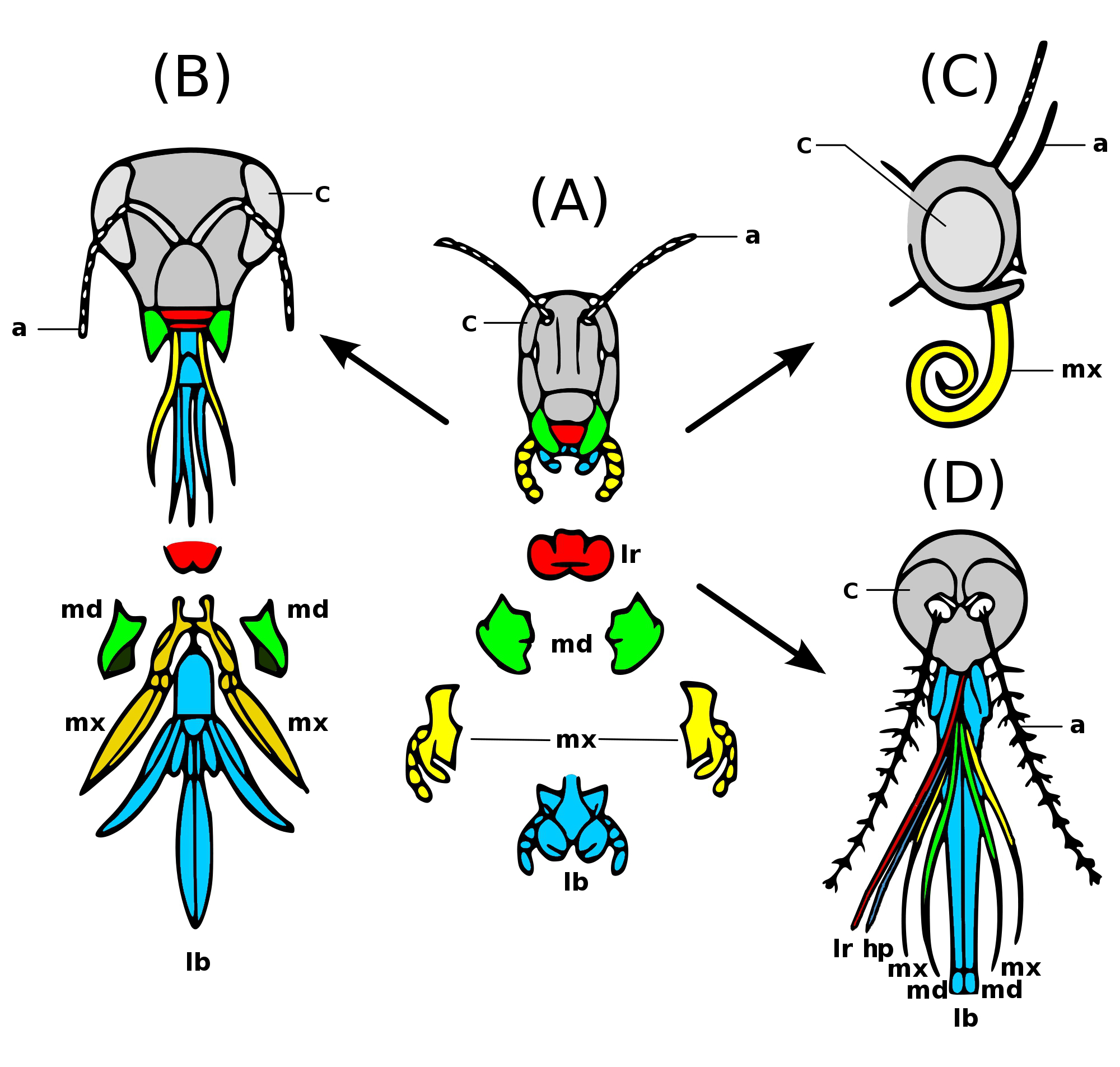|
Xyelidae
The Xyelidae are a comparatively species-poor family of sawflies, comprising about 80 extant species in five genera worldwide, and is the only family in the superfamily Xyeloidea. The fossil record of the family is extensive, comprising more than 120 species and including the oldest fossil Hymenoptera species dating back to the Triassic, between 245 and 208 million years ago. Xyelidae are the most basal contemporary lineage of Hymenoptera and have many ancestral morphological features. The extant species occur in the Northern Hemisphere, especially in boreal regions of the Holarctic, though there are a few Oriental species. Two genera and about 15 species occur in Europe.Taeger, A., Blank, S.M. & Liston, A. D. 2006: European Sawflies (Hymenoptera: Symphyta) – A Species Checklist for the Countries. Pp. 399-504. In: Blank, S.M., Schmidt, S. & Taeger, A. (eds): Recent Sawfly Research: Synthesis and Prospects. Goecke & Evers, Keltern.Blank, S.M. 2002: Biosystematics of the extant ... [...More Info...] [...Related Items...] OR: [Wikipedia] [Google] [Baidu] |
Sawflies
Sawflies are wasp-like insects that are in the suborder Symphyta within the order Hymenoptera, alongside ants, bees, and wasps. The common name comes from the saw-like appearance of the ovipositor, which the females use to cut into the plants where they lay their eggs. The name is associated especially with the Tenthredinoidea, by far the largest superfamily in the suborder, with about 7,000 known species; in the entire suborder, there are 8,000 described species in more than 800 genera. Symphyta is paraphyletic, consisting of several basal groups within the order Hymenoptera, each one rooted inside the previous group, ending with the Apocrita which are not sawflies. The primary distinction between sawflies and the Apocrita – the ants, bees, and wasps – is that the adults lack a "wasp waist", and instead have a broad connection between the abdomen and the thorax. Some sawflies are Batesian mimics of wasps and bees, and the ovipositor can be mistaken for a stinger. S ... [...More Info...] [...Related Items...] OR: [Wikipedia] [Google] [Baidu] |
Megaxyela
''Megaxyela'' is a genus of sawflies in the family Xyelidae. There are about 13 described species in ''Megaxyela'', found in the eastern Nearctic and in the southeastern part of East Asia East Asia is a geocultural region of Asia. It includes China, Japan, Mongolia, North Korea, South Korea, and Taiwan, plus two special administrative regions of China, Hong Kong and Macau. The economies of Economy of China, China, Economy of Ja .... Two fossil species have been discovered, in Colorado and Shandong, China. ''Megaxyela'' are external feeders of trees in the walnut family, Juglandaceae. Species These 13 species belong to the genus ''Megaxyela'': * '' Megaxyela bicoloripes'' (Rohwer, 1924) * '' Megaxyela euchroma'' Blank, Shinohara & Wei, 2017 * '' Megaxyela fulvago'' Blank, Shinohara & Wei, 2017 * '' Megaxyela gigantea'' Mocsáry, 1909 * '' Megaxyela inversa'' Blank & D.R. Smith, 2017 * '' Megaxyela langstoni'' Ross, 1936, 2017 * '' Megaxyela major'' (Cresson, 1880) * '' Mega ... [...More Info...] [...Related Items...] OR: [Wikipedia] [Google] [Baidu] |
Hymenoptera
Hymenoptera is a large order of insects, comprising the sawflies, wasps, bees, and ants. Over 150,000 living species of Hymenoptera have been described, in addition to over 2,000 extinct ones. Many of the species are parasitic. Females typically have a special ovipositor for inserting eggs into hosts or places that are otherwise inaccessible. This ovipositor is often modified into a stinger. The young develop through holometabolism (complete metamorphosis)—that is, they have a wormlike larval stage and an inactive pupal stage before they reach adulthood. Etymology The name Hymenoptera refers to the wings of the insects, but the original derivation is ambiguous. All references agree that the derivation involves the Ancient Greek πτερόν (''pteron'') for wing. The Ancient Greek ὑμήν (''hymen'') for membrane provides a plausible etymology for the term because species in this order have membranous wings. However, a key characteristic of this order is that the hi ... [...More Info...] [...Related Items...] OR: [Wikipedia] [Google] [Baidu] |
Triassic
The Triassic ( ; sometimes symbolized 🝈) is a geologic period and system which spans 50.5 million years from the end of the Permian Period 251.902 million years ago ( Mya), to the beginning of the Jurassic Period 201.4 Mya. The Triassic is the first and shortest period of the Mesozoic Era and the seventh period of the Phanerozoic Eon. Both the start and end of the period are marked by major extinction events. The Triassic Period is subdivided into three epochs: Early Triassic, Middle Triassic and Late Triassic. The Triassic began in the wake of the Permian–Triassic extinction event, which left the Earth's biosphere impoverished; it was well into the middle of the Triassic before life recovered its former diversity. Three categories of organisms can be distinguished in the Triassic record: survivors from the extinction event, new groups that flourished briefly, and other new groups that went on to dominate the Mesozoic Era. Reptiles, especially archosaurs, were the ... [...More Info...] [...Related Items...] OR: [Wikipedia] [Google] [Baidu] |
Juglandaceae
The Juglandaceae are a plant family known as the walnut family. They are trees, or sometimes shrubs, in the order Fagales. Members of this family are native to the Americas, Eurasia, and Southeast Asia. The nine or ten genera in the family have a total of around 50 species, and include the commercially important nut-producing trees walnut (''Juglans''), pecan (''Carya illinoinensis''), and hickory (''Carya''). The Persian walnut, '' Juglans regia'', is one of the major nut crops of the world. Walnut, hickory, and gaulin are also valuable timber trees while pecan wood is also valued as cooking fuel. Description Members of the walnut family have large, aromatic leaves that are usually alternate, but opposite in '' Alfaroa'' and '' Oreomunnea''. The leaves are pinnately compound or ternate, and usually 20–100 cm long. The trees are wind-pollinated, and the flowers are usually arranged in catkins. The fruits of the Juglandaceae are often confused with drupes but are ac ... [...More Info...] [...Related Items...] OR: [Wikipedia] [Google] [Baidu] |
Ulmus
Elms are deciduous and semi-deciduous trees comprising the genus ''Ulmus'' in the family Ulmaceae. They are distributed over most of the Northern Hemisphere, inhabiting the temperate and tropical- montane regions of North America and Eurasia, presently ranging southward in the Middle East to Lebanon and Israel,Flora of Israel OnlineUlmus minor Mill. , Flora of Israel Online accessdate: July 28, 2020 and across the Equator in the Far East into Indonesia.Fu, L., Xin, Y. & Whittemore, A. (2002). Ulmaceae, in Wu, Z. & Raven, P. (eds) Flora of China'', Vol. 5 (Ulmaceae through Basellaceae). Science Press, Beijing, and Missouri Botanical Garden Press, St. Louis, US. Elms are components of many kinds of natural forests. Moreover, during the 19th and early 20th centuries, many species and cultivars were also planted as ornamental street, garden, and park trees in Europe, North America, and parts of the Southern Hemisphere, notably Australasia. Some individual elms reached great size ... [...More Info...] [...Related Items...] OR: [Wikipedia] [Google] [Baidu] |
Antenna (biology)
An antenna (plural: antennae) is one of a pair of appendages used for Sensory system, sensing in arthropods. Antennae are sometimes referred to as ''feelers''. Antennae are connected to the first one or two Segmentation (biology), segments of the arthropod head. They vary widely in form but are always made of one or more jointed segments. While they are typically sensory organs, the exact nature of what they sense and how they sense it is not the same in all groups. Functions may variously include sensing tactition, touch, air motion, heat, vibration (sound), and especially insect olfaction, smell or gustation, taste. Antennae are sometimes modified for other purposes, such as mating, brooding, swimming, and even anchoring the arthropod to a substrate (biology), substrate. Larval arthropods have antennae that differ from those of the adult. Many crustaceans, for example, have free-swimming larvae that use their antennae for swimming. Antennae can also locate other group members i ... [...More Info...] [...Related Items...] OR: [Wikipedia] [Google] [Baidu] |
Insect Mouthparts
Insects have arthropod mouthparts, mouthparts that may vary greatly across insect species, as they are adapted to particular modes of feeding. The earliest insects had chewing mouthparts. Most specialisation of mouthparts are for piercing and sucking, and this mode of feeding has evolved a number of times independently. For example, mosquitoes (which are true flies) and aphids (which are Hemiptera, true bugs) both pierce and suck, though female mosquitoes feed on animal blood whereas aphids feed on plant fluids. Evolution Like most external features of arthropods, the mouthparts of Hexapoda are highly derived. Insect mouthparts show a multitude of different functional mechanisms across the wide diversity of insect species. It is common for significant Homology (biology), homology to be conserved, with matching structures forming from matching Primordium, primordia, and having the same evolutionary origin. However, even if structures are almost physically and functionally identica ... [...More Info...] [...Related Items...] OR: [Wikipedia] [Google] [Baidu] |
Arthropod Leg
The arthropod leg is a form of jointed appendage of arthropods, usually used for walking. Many of the terms used for arthropod leg segments (called podomeres) are of Latin origin, and may be confused with terms for bones: ''coxa'' (meaning hip (anatomy), hip, : ''coxae''), ''trochanter'', ''femur'' (: ''femora''), ''tibia'' (: ''tibiae''), ''tarsus'' (: ''tarsi''), ''ischium'' (: ''ischia''), ''metatarsus'', ''carpus'', ''dactylus'' (meaning finger), ''patella'' (: ''patellae''). Homology (biology), Homologies of leg segments between groups are difficult to prove and are the source of much argument. Some authors posit up to eleven segments per leg for the most recent common ancestor of Neontology, extant arthropods but modern arthropods have eight or fewer. It has been argued that the ancestral leg need not have been so complex, and that other events, such as successive loss of function of a Homeobox, ''Hox''-gene, could result in Parallel evolution, parallel gains of leg segments ... [...More Info...] [...Related Items...] OR: [Wikipedia] [Google] [Baidu] |
Homeobox
A homeobox is a Nucleic acid sequence, DNA sequence, around 180 base pairs long, that regulates large-scale anatomical features in the early stages of embryonic development. Mutations in a homeobox may change large-scale anatomical features of the full-grown organism. Homeoboxes are found within genes that are involved in the regulation of patterns of anatomical development (morphogenesis) in animals, fungus, fungi, plants, and numerous single cell eukaryotes. Homeobox genes encode homeodomain protein products that are transcription factors sharing a characteristic protein fold structure that binds DNA to regulate expression of target genes. Homeodomain proteins regulate gene expression and cell differentiation during early embryonic development, thus mutations in homeobox genes can cause developmental disorders. Homeosis is a term coined by William Bateson to describe the outright replacement of a discrete body part with another body part, e.g. antennapedia—replacement of t ... [...More Info...] [...Related Items...] OR: [Wikipedia] [Google] [Baidu] |
Pollen
Pollen is a powdery substance produced by most types of flowers of seed plants for the purpose of sexual reproduction. It consists of pollen grains (highly reduced Gametophyte#Heterospory, microgametophytes), which produce male gametes (sperm cells). Pollen grains have a hard coat made of sporopollenin that protects the gametophytes during the process of their movement from the stamens to the pistil of flowering plants, or from the male Conifer cone, cone to the female cone of gymnosperms. If pollen lands on a compatible pistil or female cone, it Germination, germinates, producing a pollen tube that transfers the sperm to the ovule containing the female gametophyte. Individual pollen grains are small enough to require magnification to see detail. The study of pollen is called palynology and is highly useful in paleoecology, paleontology, archaeology, and Forensic science, forensics. Pollen in plants is used for transferring Ploidy#Haploid and monoploid, haploid male genetic ma ... [...More Info...] [...Related Items...] OR: [Wikipedia] [Google] [Baidu] |








